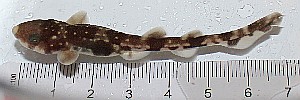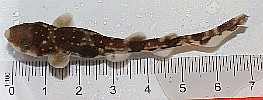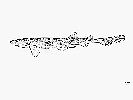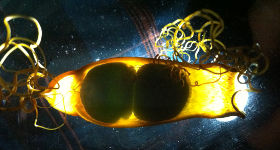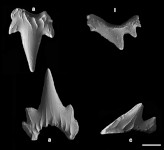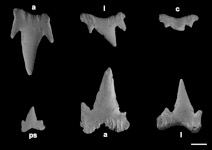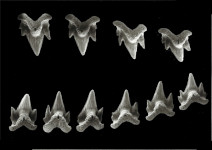Scyliorhinus torazame
(Tanaka, 1908)
Cloudy catshark
Classification: Elasmobranchii Carcharhiniformes Scyliorhinidae
Reference of the original description
Notes on Some Japanese Fishes, with Descriptions of Fourteen New Species. Journal of the College of Science, Imperial University, Tokyo, 23(7), 1–60
Notes on Some Japanese Fishes, with Descriptions of Fourteen New Species. Journal of the College of Science, Imperial University, Tokyo, 23(7), 1–60
Image of the original description
.jpg)
Scyliorhinus torazame (Tanaka, 1908)
.jpg)
Scyliorhinus torazame (Tanaka, 1908)
Synonyms / new combinations and misspellings
Catulus torazame, Halaelurus rudis, Halaelurus torazame, Scyliorhinus rudis, Scyliorhinus tokubee
Catulus torazame, Halaelurus rudis, Halaelurus torazame, Scyliorhinus rudis, Scyliorhinus tokubee
Types
Scyliorhinus torazame
Holotype: ZUMT: 953; Paratype: ZUMT: uncatalogued;
Scyliorhinus rudis
Syntype: NMW: 76981; NMW: 76980; NMW: 78638;
Scyliorhinus tokubee
Holotype: HUMZ: 107358; Paratype: HUMZ: 117496; HUMZ: 117472; HUMZ: 113574; HUMZ: 113578; NSMT: P 34976;
Scyliorhinus torazame
Holotype: ZUMT: 953; Paratype: ZUMT: uncatalogued;
Scyliorhinus rudis
Syntype: NMW: 76981; NMW: 76980; NMW: 78638;
Scyliorhinus tokubee
Holotype: HUMZ: 107358; Paratype: HUMZ: 117496; HUMZ: 117472; HUMZ: 113574; HUMZ: 113578; NSMT: P 34976;
Description :
Citation: Scyliorhinus torazame (Tanaka, 1908): In: Database of modern sharks, rays and chimaeras, www.shark-references.com, World Wide Web electronic publication, Version 01/2026
Please send your images of "Scyliorhinus torazame" to info@shark-references.com
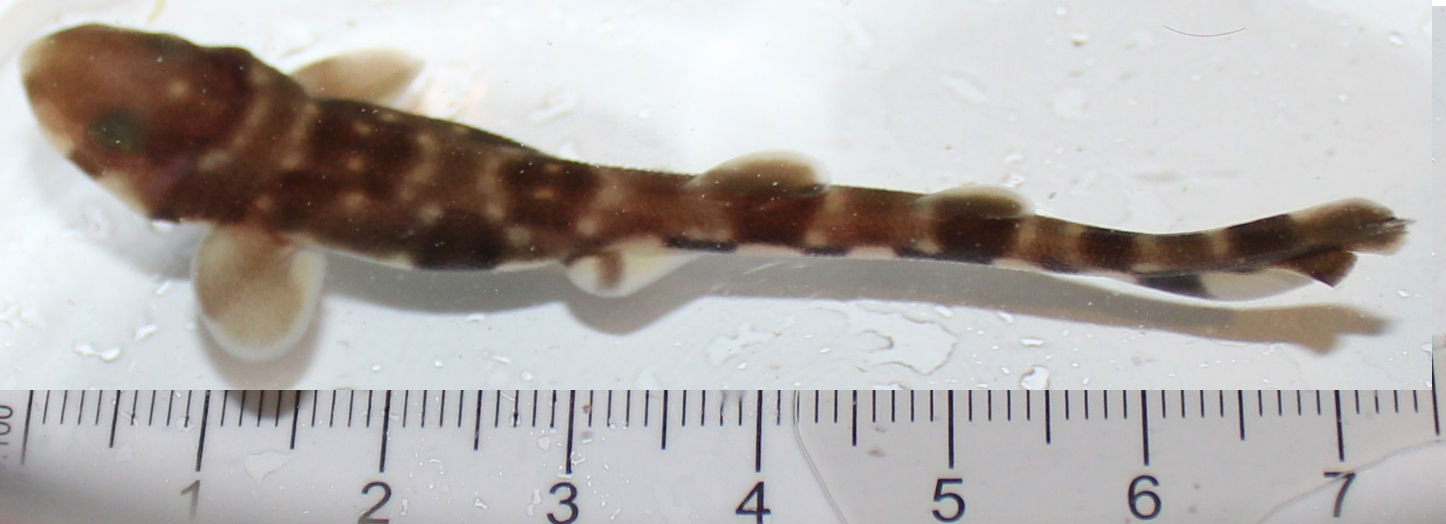
Scyliorhinus torazame (Tanaka, 1908) © Chris Avila, Toronto Bentic Sharks, Canadian Marine Aquaculture, Toronto

Scyliorhinus torazame (Tanaka, 1908) © Chris Avila, Toronto Bentic Sharks, Canadian Marine Aquaculture, Toronto
Common names
 Alitán nubarrado,
Alitán nubarrado,  Roussette nuageuse,
Roussette nuageuse,  Cloudy cat shark,
Cloudy cat shark,  Cloudy catshark
Cloudy catshark
 Alitán nubarrado,
Alitán nubarrado,  Roussette nuageuse,
Roussette nuageuse,  Cloudy cat shark,
Cloudy cat shark,  Cloudy catshark
Cloudy catshark
Short Description
Diagnosis after Compagno, 1984 [517]: Field Marks: A fairly small, slender, dark-saddled catshark with or without scattered large irregular dark and light spots, very rough skin, small anterior nasal flaps that do not reach mouth, no nasoral grooves, labial furrows on lower jaw only, second dorsal fin much smaller than first. Diagnostic Features: Head and body relatively deep, slender and narrow. Greatest width of head about 2/3 of head length; no nasoral grooves; anterior nasal flaps not expanded and falling in front of mouth. First dorsal origin about opposite pelvic insertions; second dorsal origin well anterior to anal insertion; interdorsal space considerably greater than anal base; claspers with a row of strongly differentiated hooks on exorhipidion. Denticles large and erect, surface of skin very rough. Colour pattern of 6 to 9 obscure dusky saddles, interspersed in larger specimens by many irregular large dark and light spots. Monospondylous precaudal centra 33 to 38. Size moderate, adults below 50 cm.
Diagnosis after Compagno, 1984 [517]: Field Marks: A fairly small, slender, dark-saddled catshark with or without scattered large irregular dark and light spots, very rough skin, small anterior nasal flaps that do not reach mouth, no nasoral grooves, labial furrows on lower jaw only, second dorsal fin much smaller than first. Diagnostic Features: Head and body relatively deep, slender and narrow. Greatest width of head about 2/3 of head length; no nasoral grooves; anterior nasal flaps not expanded and falling in front of mouth. First dorsal origin about opposite pelvic insertions; second dorsal origin well anterior to anal insertion; interdorsal space considerably greater than anal base; claspers with a row of strongly differentiated hooks on exorhipidion. Denticles large and erect, surface of skin very rough. Colour pattern of 6 to 9 obscure dusky saddles, interspersed in larger specimens by many irregular large dark and light spots. Monospondylous precaudal centra 33 to 38. Size moderate, adults below 50 cm.
Biology
Oviparous, with only one egg laid per oviduct at a time [517]. Embryos feed solely on yolk [733]. Size at hatching at least 8 cm [517]. During courtship and prior to copulation, the male bites and wraps the female"quot;s pectoral fin, body, tail, and gills (Ref. 49562, 51119). Copulation is initiated when the male inserts one of its claspers into the female"quot;s cloaca. The whole mating episode lasts from 15 seconds to 4 minutes (Ref. 49562). A small species, lives in rocky regions. A carnivor [17641].
Oviparous, with only one egg laid per oviduct at a time [517]. Embryos feed solely on yolk [733]. Size at hatching at least 8 cm [517]. During courtship and prior to copulation, the male bites and wraps the female"quot;s pectoral fin, body, tail, and gills (Ref. 49562, 51119). Copulation is initiated when the male inserts one of its claspers into the female"quot;s cloaca. The whole mating episode lasts from 15 seconds to 4 minutes (Ref. 49562). A small species, lives in rocky regions. A carnivor [17641].
Dentition
Monognathic heterodonty gradual well developed; anterior teeth abruptly larger than the parasymphysial ones and lateral teeth smaller distally, with smaller and thicker principal cusps. Sexual heterodonty well pronounced with females presenting anterior teeth with marginal cusplet well-developed and proximal one more tapered and oblique in males (Figs. 79, 80). Tooth counts 24–38 26–38/22–42 23–40. Parasymphysial teeth with a principal cusp flanked by one cusplet on each side; cusplets half the height and the width of the principal cusp. Protuberances on medial portion of the crown base and striae restricted to the crown base. Anterior teeth larger than the parasymphysial and principal cusp less stout. Anterior teeth with two to four cusplets; marginal cusplets smaller and half the height or less of the principal cusp in upper teeth and more than half the height in lower ones. Protuberances on the crown base; striae restricted to the crown base in lower teeth and extending to half the height of the principal cusp in upper ones. Lateral with three or four cusplets; marginal cusplets half the height of proximal ones. Upper teeth with principal cusp slightly oblique; nearly straight in lower ones. Protuberances on the crown base; striae restricted to the crown base in lower teeth and extending to half the height of the principal cusp in upper ones. Commissural teeth with one cusplet; principal cusp stouter and laterally situated. Cusplet corresponding to 2/3 the height and the width of the principal cusp. Protuberances on the crown base and striae throughout the principal cusp. Ectodermal pits inconspicuous or restricted to the crown base in lateral and commissural teeth. [27296]
Monognathic heterodonty gradual well developed; anterior teeth abruptly larger than the parasymphysial ones and lateral teeth smaller distally, with smaller and thicker principal cusps. Sexual heterodonty well pronounced with females presenting anterior teeth with marginal cusplet well-developed and proximal one more tapered and oblique in males (Figs. 79, 80). Tooth counts 24–38 26–38/22–42 23–40. Parasymphysial teeth with a principal cusp flanked by one cusplet on each side; cusplets half the height and the width of the principal cusp. Protuberances on medial portion of the crown base and striae restricted to the crown base. Anterior teeth larger than the parasymphysial and principal cusp less stout. Anterior teeth with two to four cusplets; marginal cusplets smaller and half the height or less of the principal cusp in upper teeth and more than half the height in lower ones. Protuberances on the crown base; striae restricted to the crown base in lower teeth and extending to half the height of the principal cusp in upper ones. Lateral with three or four cusplets; marginal cusplets half the height of proximal ones. Upper teeth with principal cusp slightly oblique; nearly straight in lower ones. Protuberances on the crown base; striae restricted to the crown base in lower teeth and extending to half the height of the principal cusp in upper ones. Commissural teeth with one cusplet; principal cusp stouter and laterally situated. Cusplet corresponding to 2/3 the height and the width of the principal cusp. Protuberances on the crown base and striae throughout the principal cusp. Ectodermal pits inconspicuous or restricted to the crown base in lateral and commissural teeth. [27296]
Remarks
shark-references Species-ID=6369;
shark-references Species-ID=6369;
Parasites (arranged by Jürgen Pollerspöck)
Acanthocephala
Acanthocephala
- Pseudoacanthocephalus sadoensis Kita, & Nitta, Abe, Kaburagi, Fujita, T. Toyota, K. Kondo & Kajihara, 2025 [34956]








